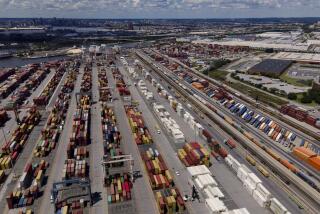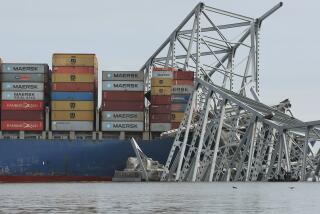Los Angeles and Long Beach ports see market share trickle away
The ports of Los Angeles and Long Beach, long the nation’s dominant shipping harbors, lost a bit of market share to East Coast docks this year.
The nation’s two top ports expect to end this year on a slightly sour note, moving 200,000 fewer cargo containers than last year at a time when total trade at the nation’s 10 biggest harbors has grown by about the same amount.
A key reason for the slower activity has been that India and Singapore are becoming major shipping hubs, and routes there favor the East Coast, especially the Port Authority of New York & New Jersey and the fast-growing Savannah, Ga., port.
Asian trade accounts for 40% of imports at the Los Angeles and Long Beach harbors, so any loss of market share is cause for concern.
“There are hundreds of thousands of containers of cargo at stake here,” said Jim MacLellan, director of trade development for the Port of Los Angeles. Singapore “is the dividing line between routes that go East and West. It’s the battleground.”
International trade has been one of Southern California’s most important providers of jobs, with firms from Ventura County to San Diego County and inland employing about 639,200 workers at the end of November, said economist John Husing, whose firm Economics & Politics Inc. focuses on the industry’s effect on the Inland Empire.
So with the abutting ports moving about 14 million cargo containers this year, a drop of 1.2% from last year, Los Angeles and Long Beach are beefing up efforts to win back business.
Both ports, for instance, are nurturing companies such as business consulting firm Elvie Corp. in La Quinta. Officials at the L.A. port have helped Elvie build lucrative Asian markets for its clients, said John Aguero, the company’s executive vice president.
Elvie finds Asian customers for domestic goods from across the U.S. The list includes a U.S. coffee brand from Virginia, chicken and other poultry from the Midwest and frozen foods from Arizona. Elvie moves all of it through the Port of Los Angeles.
“We are a facilitator for about eight U.S. companies now,” Aguero said. “And we have another 15 companies that we are finalizing deals with. This is already beyond our expectations. We are totally explosive.”
Aguero said his company’s sales are expected to increase to $65 million next year from $5 million eight years ago.
The Port of Los Angeles has been taking its export help directly to businesses “almost like speed dating,” MacLellan said.
“These companies don’t have a lot of time to spend outside of their businesses,” he said. “The No. 1 thing is helping them find an overseas market.”
It’s already begun to pay off. Despite the slight downturn in overall trade, Los Angeles set a record this year for the number of containers exported.
The neighboring Port of Long Beach has made similar efforts, such as hosting a forum for small U.S. businesses with the Export-Import Bank of the United States. J. Christopher Lytle, the port’s new executive director, said there’s a need to constantly promote the strengths of the local ports.
“Ultimately, it comes down to which ports have the better facilities, the best efficiency and the greater numbers of options for destinations and sailing times,” Lytle said. “Marketing our strengths is important. We will not be complacent about this.”
The ports have long benefited from having the fastest sea routes to China, Taiwan, Japan and South Korea — Asia’s major exporters.
But southern Asia and South Pacific nations are rising in international trade. Australia has displaced Taiwan for fourth place in trade with the Los Angeles Customs District. Close behind are Singapore, Thailand, India and Malaysia.
With the option of heading west through the Suez Canal, shippers in those countries need to be convinced that Los Angeles and Long Beach are better destinations.
These days, the East Coast ports are booming. At the New York and New Jersey port authority, the third-largest U.S. port, the number of cargo containers moved through the docks has risen 5.3% this year. Savannah, the fourth-largest port, has seen a 3.6% increase this year.
Despite those increases, Los Angeles and Long Beach remain strong. Overall, the twin ports’ share of international cargo containers moved by the 10 largest North American ports has fallen to 41.7% this year from 42.6% last year.
However, five years ago, the local ports moved 1.7 million more containers than expected for 2011 and employed 69,000 more workers. And port officials and business leaders are concerned that more business will be lost starting in 2014 when an expanded Panama Canal makes it possible for larger cargo ships to head to docks on the Gulf Coast and East Coast.
In March, the two local ports got a boost when President Obama pushed his export initiative during a Southern California visit, said Vance Baugham, president of the World Trade Center Assn. Los Angeles-Long Beach.
“The most aggressive world markets today are in Asia,” he said, “and we have to reflect that through our ports.”







